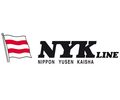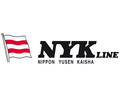[ad_1]

1.Qualitative Information on Quarterly Results
(1)Review of Operating Results
In the first quarter of the fiscal year ending March 31, 2023 (April 1, 2022 to June 30, 2022), consolidated revenues amounted to ¥673.0 billion (increased by ¥168.4 billion compared to the first quarter of the previous fiscal year), operating profit amounted to ¥89.1 billion (increased by ¥36.1 billion), recurring profit amounted to ¥377.7 billion (increased by ¥224.1 billion), profit attributable to owners of parent amounted to ¥343.3 billion (increased by ¥192.2 billion).
Due to the strong performance of OCEAN NETWORK EXPRESS PTE. LTD. (ONE), our equity-method affiliate, equity in earnings of unconsolidated subsidiaries and affiliates of ¥274.3 billion in non-operating income was recorded. Within this amount, equity in earnings of affiliates from ONE was ¥264.4 billion.
Changes in the average exchange rate between the U.S. dollar and yen as well as the average bunker oil price during the first quarter of the current and previous fiscal years are shown in the following tables.
Overview by Business Segment
Business segment information for the three months ended June 30, 2022 (April 1, 2022 to June 30, 2022) is as follows.
Liner Trade Business
In the container shipping division, although ONE was affected by the overall supply chain disruptions caused by port congestion, as well as the lockdowns in China and the situation in Russia and Ukraine, freight rates remained high, and the financial results were strong. In the major trades, sailings were voided in the North America trade as turnaround times grew longer due to port congestion and cargo volumes declined due to the lockdowns in China. As a result, both liftings and utilization fell compared to the same period last year. In the Europe trade, too, both liftings and utilization fell compared to the same period last year due to port congestion caused by the impact of the lockdowns and containers destined for Russia piling up at the ports. On the other hand, freight rates were higher than the same period last year on both trades, driving the overall results.
At the terminals in Japan, although handling volumes slightly declined due to delays in the containership voyage schedules and the impact of the lockdowns, they remained generally unchanged from the same period last year. At the overseas terminals, handling volumes declined compared to the same period last year due to the sale of several terminals in North America.
As a result of the above, profit increased on higher revenue in the overall Liner Trade Business compared to the same period last year.
Air Cargo Transportation Business
In the Air Cargo Transportation Business, cargo volumes slowed slightly due to the impact of the lockdowns in China and other factors. As a result of the widespread suspension of flights on the Shanghai service and cancellation of flights on the Europe service due to the situation in Russia and Ukraine, supplied space and shipping volumes were below the initial plan. However, freight rates remained high on support from strong transportation demand for semiconductor manufacturing equipment and the long-term contracts renewed under the favorable market conditions.
As a result of the above, profit increased on higher revenue in the overall Air Cargo Transportation Business compared to the same period last year.
Logistics Business
In the air freight forwarding business, although the tight supply-and-demand conditions started to slacken following the return of international passenger flights, sales prices trended at high levels compared to the same period last year. As a result, a certain profit level was achieved despite the lower handling volumes year on year caused by the impact of the lockdowns in China and other factors.
In the ocean freight forwarding business, handling volumes declined compared to the same period last year due to slower shipments caused by the lockdowns and other factors, but profit levels remained firm as a result of sales prices remaining high and efforts to expand sales of ancillary services such as customs clearance.
In the contract logistics business, although labor and energy costs soared particularly in Europe and the United States, handling volumes increased compared to the same period last year through active shipments mainly due to strong demand for consumer goods.
In the coastal transportation business, although handling volumes declined on several services, they increased in the ferry business, and the overall financial results benefited from the yen’s depreciation and soaring feeder freight rates.
As a result of the above, profit increased on higher revenue in the overall Logistics Business compared to the same period last year.
Bulk Shipping Business
In the automotive transportation division, although the automobile production volumes declined due to the shortage of automotive components caused by COVID-19 and the global semiconductor shortage, vessel utilization was improved by optimizing vessel deployment plan and sailing schedules. As a result, transportation volumes were generally unchanged compared to the same period last year, and the financial results benefited from the foreign exchange rate. Also, the procurement of eco-friendly vessels is being actively promoted, and the second LNG-fueled pure car and truck carrier has entered service. In the auto logistics business, following the changes in the business environment, the scope of operations in some regions was revised, and actions were taken to increase profitability while reorganizing the portfolio, including acquiring shipments from China. At the same time, preparations were made for opening the finished-car terminal in Egypt and efforts were made to develop new business.
In the dry bulk business division, the Capesize market temporarily recovered after the seasonal market correction ended in late April when the increased vessel waiting times in China due to the lockdowns combined with more active shipments of coal. This unseasonal rise in market levels was subsequently followed by a rapid fall. From June, the market fell further as concerns about slowing global economic activity increased, and the market trended at levels below the same period last year. In the Panamax segment, strong cargo volumes of grain and coal caused markets to remain at levels exceeding the previous year until May. Thereafter, the market levels started to decline in line with the deterioration in the Capesize market, but overall, the market trended at levels above the same period last year. Also, in the
Handymax and Handy markets, the cross trade particularly from the Pacific Ocean to Atlantic Ocean became more active, and shipments of minor bulk cargo were strong, causing markets to trend at levels exceeding the same period last year. Within this environment, along with fixing revenue through the use of futures contracts to minimize the impact of market fluctuations, efforts were made to stabilize revenue by securing long-term contracts and reduce costs through efficient operations.
In the energy business division, the supply-and-demand balance for VLCC (Very Large Crude Carrier) did not improve, and markets remained at historic lows. In the petrochemical tanker market, due to the impact of the situation in Russia and Ukraine, the origin of shipments bound for Europe shifted from Russia to the United States and India, resulting in longer sailing distances. The subsequent decline in shipping capacity supply caused supply-and-demand conditions to tighten, leading to greatly higher market levels compared to the same period last year. In the VLGC (Very Large LPG Carrier) market, the supply-and-demand balance tightened due to congestion at the Panama Canal and strong cargo volumes to Europe despite seasonally weaker demand, and the market trended at levels exceeding the same period last year. In LNG carriers, the results were steady based on support from the long-term contracts that generate stable earnings. Also, in the offshore business, FPSO (Floating Production, Storage and Offloading) and drill ships were steady.
As a result of the above, the overall Bulk Shipping Business recorded increased profit on higher revenue
compared to the same period last year.
Also, in the energy business division, an extraordinary loss of about ¥17.8 billion was recorded in the LNG carrier business in relation to LNG transportation involving the Sakhalin 2 project due to the deteriorating business environment caused by the situation in Russia and Ukraine.
Real Estate and Other Businesses
In the Real Estate Business, profit decreased on lower revenue compared to the same period last year following the partial transfer of shares of a subsidiary in the last fiscal year.
In Other Business Services, although some of the manufacturing businesses did not perform as well as last year due to the impact of higher oil prices, strong performances by the bunker fuel sales business and marine equipment supplies sales business drove the overall results. In the cruise business, operations were suspended in late March due to a problem involving the electrical equipment aboard the ship, but cruises resumed from early June. As a result of the above, revenue increased in Other Business Services compared to the same period last year, and a profit was recorded.
Full Report
Source: Nippon Yusen Kabushiki Kaisha
[ad_2]
Source link








